NEW DELHI:Brain connectivity In people born blind, the primary visual cortex, the brain region known to process visual information, develops unique patterns different to those in people with sight, researchers said, likening these patterns to an “individual fingerprint. “They said that the connectivity in the visual cortices of people who can see did not show such varied changes and were “usually fairly consistent.”

“The connectivity pattern in people born blind is more different across people, like an individual fingerprint, and is stable over time — so much so that the individual person can be identified from the connectivity pattern,” said lead author Ella Striem-Amit, an assistant professor of neuroscience at the Georgetown University, US.
Brain connectivity
In individuals born blind, the primary visual cortex, which processes visual information, forms unique patterns distinct from those in sighted individuals. Researchers compared these patterns to “individual fingerprints.” They noted that the connectivity in the visual cortices of sighted people did not exhibit such varied changes and remained “usually fairly consistent. “The connectivity pattern in people born blind is more different across people, like an individual fingerprint, and is stable over time — so much so that the individual person can be identified from the connectivity pattern,” said lead author Ella Striem-Amit, an assistant professor of neuroscience at the Georgetown University, US.

The study, featured in the Proceedings of the National Academy of Sciences (PNAS), involved a small group of individuals born blind who underwent multiple functional MRI scans over a two-year period. Analyzing these scans, researchers discovered that the unique connectivity patterns exhibited “remarkable stability” over time.”Our study found that these patterns did not change significantly based on the task at hand — whether participants were localising sounds, identifying shapes, or simply resting.
Instead, the connectivity patterns were unique to each individual and remained stable over the two-year study period,” said Lenia Amaral, a postdoctoral researcher at Georgetown University.
The authors indicated that life experiences, particularly growing up without sight, significantly influence the unique ways in which the brain develops.”Brain plasticity in these cases frees the brain to develop, possibly even for different possible uses for the visual cortex among different people born blind,” Striem-Amit said.

Brain plasticity, also known as neuroplasticity, is the brain’s ability to reorganize and restructure itself in response to environmental changes. The authors suggested that understanding individual connectivity patterns could aid in developing personalized solutions for restoring sight in people born blind The study, led by Lenia Amaral, PhD, and Ella Striem-Amit, PhD, explores how the visual cortex in individuals born blind responds to various stimuli, including touch and sound. Unlike the consistent visual cortex connectivity in sighted people, blind individuals exhibit highly individual patterns that are stable over time.
The research involved functional MRI scans of blind participants over two years, revealing that their connectivity patterns remained consistent regardless of tasks such as localising sounds or identifying shapes.
Amaral noted, “These patterns did not change significantly based on the task at hand, underscoring the uniqueness and stability of these neural connections.”

“We don’t see this level of variation in the visual cortex connectivity among individuals who can see,” said Striem-Amit. “The connectivity pattern in people born blind is like an individual fingerprint, identifiable and stable over time.”
Striem-Amit highlighted the implications for brain development: “Our findings suggest that experiences after birth shape diverse brain development pathways, particularly in those growing up without sight. This brain plasticity allows for varied uses of the visual cortex.”
The study suggests that understanding each individual’s connectivity could be crucial for developing tailored solutions in rehabilitation and sight restoration.
Stay connected with Fact and US for more such news.
